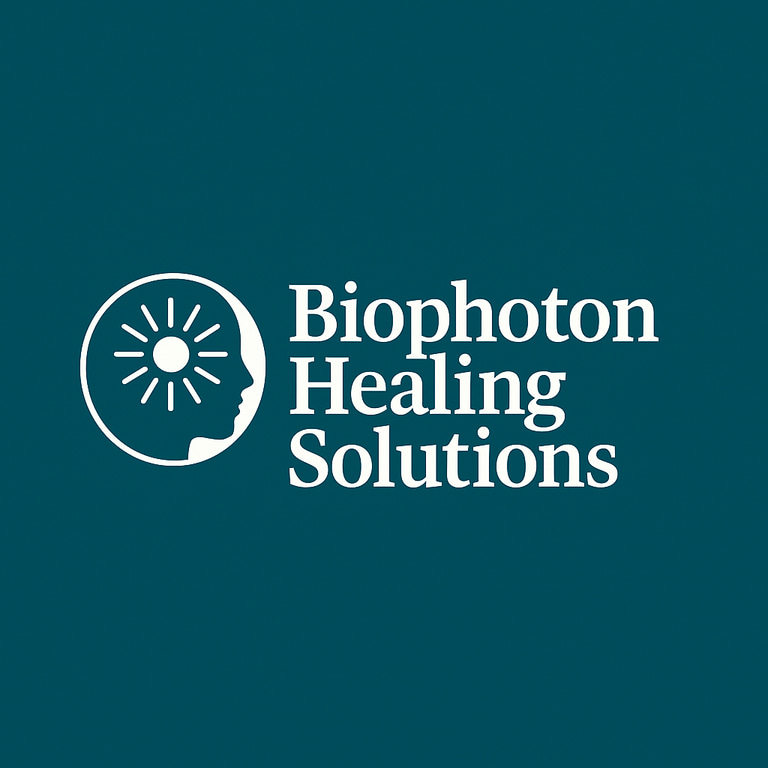Biophoton Research Summary Page
BioPhotons Defined: BioPhotons are ultra-weak light emissions produced by living cells, typically in the UV–visible range. They occur as byproducts of metabolic reactions (especially oxidative processes) and are so faint that sensitive equipment is required to detect them. First discovered by Gurwitsch in the 1920s and later termed “biophotons” by Fritz-Albert Popp in 1984, these emissions are coherent and may play a role in cellular communicationpmc.ncbi.nlm.nih.gov.
Presence in the Body & Function: All parts of the body emit biophotons, with the skin being a primary surface from which they can be measured. High metabolic organs like the brain have higher UPE output. While their exact function is not fully confirmed, biophotons are hypothesized to contribute to intracellular and intercellular signaling, maintaining biological rhythms and coherence. Healthy tissues show more coherent, rhythmic light emission, whereas stressed or diseased tissues emit photons in a more chaotic way. This suggests biophotons could reflect the physiological state and potentially serve as an “optical language” of the cells, though they might also simply be metabolic noise.
Natural vs. Artificial Generation: Naturally, biophotons are generated by reactive oxygen species and other excited molecules during normal cellular metabolism. Key pathways include mitochondrial respiration and lipid peroxidation, which create excited states that release photons as they return to ground state. Artificially, biophoton-like emissions can be generated through photobiomodulation devices (low-level lasers/LEDs that stimulate cells) and specialized biophoton generator machines. These devices emit weak light/energy fields (often using infrared or “scalar” waves) intended to amplify the body’s own biophoton fieldemmind.net. In lab settings, chemicals or nanoparticles can also induce or enhance biophoton emission for study.
Regenerating/Enhancing Biophotons: To “regenerate” biophotons in the body means to boost the intensity or coherence of the body’s biophoton emissions. Methods include: healthy lifestyle (fresh, high-“light” foods and ample sunlight exposure to charge the body’s stores of photonic energy); stress reduction and antioxidant support (to optimize the oxidative balance, since oxidative stress increases chaotic UPE); low-level light therapy (applying red/infrared light to tissues, known to increase cellular energy and could raise UPE output)pubmed.ncbi.nlm.nih.gov; and using biophoton therapy devices that bathe the body in a coherent light field.
For example, Tesla BioHealing’s generators are reported to significantly increase the body’s natural production of new cells by providing a continuous biophoton energy environment. All these approaches aim to replenish the body’s “light quotient” and restore biophoton coherence, theoretically supporting better health and regeneration.
Stem Cells and BioPhoton Therapy: Stem cells are the body’s master cells for repair, and biophoton therapy appears to interact beneficially with them. Research in photobiomodulation shows that exposing stem cells to certain light wavelengths boosts their proliferation and differentiation capacitypubmed.ncbi.nlm.nih.govpubmed.ncbi.nlm.nih.gov. In the emerging field of biophoton therapy, this is taken a step further – the goal is to stimulate the patient’s own stem cells non-invasively. Clinical efforts like a current trial are investigating whether biophoton generator devices can increase circulating stem cell counts in adults. Moreover, biophoton devices have shown early promise in promoting stem cell activity and tissue repair in various case studies and pilot studies. Essentially, stem cells are seen as the mediators of healing that biophoton therapy seeks to activate or “energize.”
How the Body Generates/Regenerates Stem Cells: The body maintains stem cell pools in specific niches (e.g. bone marrow for blood, basal layer for skin, intestinal crypts for the gut, etc.). These adult stem cells arise from development and persist through life, dividing to self-renew and produce new specialized cells as needed. Regeneration of stem cells happens by self-renewal divisions – a stem cell splits to form at least one new stem cell, thus keeping the reserve going. This process is regulated by niche signals, hormones, and even neural inputs. When injury or wear occurs, stem cells are signaled to activate, proliferate, and replace lost cells (for instance, muscle satellite cells repairing muscle fibers, or hematopoietic stem cells increasing blood cell output after bleeding). In short, stem cells are constantly at work repairing tissues and the body regenerates its stem cell populations by balancing their quiescence and division in response to the body’s needs.
Can BioPhoton Therapy Help Renew Stem Cells? Preliminary evidence suggests yes. Biophoton therapy (and related light therapies) can create conditions that are favorable for stem cell renewal and replication. Low-level light has been shown to trigger stem cells to proliferatepubmed.ncbi.nlm.nih.gov. Biophoton generator devices claim to increase the body’s natural stem cell production (one trial reports aims to show a natural stem cell increase under biophoton exposure).
Mechanistically, biophoton therapy likely boosts mitochondrial function and blood flow while reducing inflammatory signalspubmed.ncbi.nlm.nih.gov – a combination that can “wake up” stem cells in their niches. Patients using biophoton therapy have reported faster healing and rejuvenation, which implies enhanced stem cell-mediated repairpr.com. While more research is needed for definitive proof, early clinical insights and peer-reviewed studies indicate that biophoton therapy may indeed promote the regeneration and self-renewal of stem cells, helping the body heal and possibly slowing aspects of aging by tapping into its own regenerative cells.pubmed.ncbi.nlm.nih.gov
